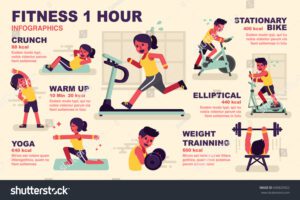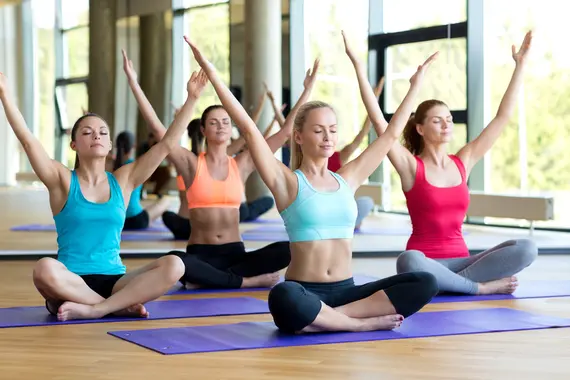A Balanced Excercise Plan Fit For Life
A balanced exercise plan combines cardiovascular activities like running or cycling to improve heart health and endurance, strength training exercises such as weightlifting or bodyweight exercises to build muscle and bone strength, flexibility exercises like yoga or stretching to maintain joint mobility and prevent injury, and rest days to allow the body to recover and adapt to the demands of exercise. By incorporating each of these components into your routine, you can achieve a well-rounded fitness regimen that supports your physical and mental health goals.
1.Cardiovascular Fitness

Cardiovascular fitness, or cardiorespiratory fitness (CRF), assesses your body’s efficiency in oxygen uptake and delivery to muscles and organs during extended exercise sessions. Higher CRF levels typically correlate with a reduced risk of developing various health conditions
Examples of cardiovascular endurance activities include:
- Swimming
- Riding a bike
- jumping jacks
- Jumping rope
- Jogging
- Dancing
- walking
- Climbing stairs
2.Strength Training

Strength training, also referred to as resistance training, aims to enhance muscular strength and fitness by engaging specific muscle groups against external resistance. This resistance can be provided by various means such as free weights, weight machines, or utilizing your body weight, as outlined by the National Academy of Sports Medicine (NASM).
The basic principle is to apply a load and overload the muscle so it needs to adapt and get stronger.
3.Flexibility And Mobility
Mobility is “your ability to achieve and control a certain range of motion,” said New York City-based physical therapist and trainer Laura Miranda, DPT, CSCS, founder of Pursuit, the fitness training system.
- Mobility for Hip flexors and lower back-Reverse Lunge With Side Bend
- Mobility for Hamstrings, lower back, ankles, shoulder, and neck-Squat to Forward Fold
- Mobility for Hip flexors, mid back, neck, and shoulders-Low Lunge With Rotation
- Mobility for Hips and glutes-Shin Box to Forward Step
- Mobility for Inner thighs- Lateral Lunge To Plank Walkout
- Mobility for Hamstrings, lower back, and glutes–Single-leg Deadlift To Knee Drive
4.Rest And Recovery
Rest days are as vital as exercise itself. A well-rounded fitness routine isn’t fulfilled without adequate rest periods.
Incorporating regular breaks facilitates the body’s recovery and rejuvenation process, which is fundamental for progress, irrespective of one’s fitness level or athletic pursuit. Neglecting rest days may result in overtraining or exhaustion.
BENEFITS:
- Allows time for recovery
- Prevents muscle fatigue
- Reduces risk of injury
- Improves performance
- Supports healthy sleep
This includes activities like leisurely walking or slow dancing.You can also have an active rest day by doing a light workout, like gentle stretching.
5.Nutrition And Hydration
Having a well-structured diet plan is essential for getting the most out of your daily workouts and aiding in recovery, especially as you prepare for significant events like races or important games. And when it comes to fueling up before these occasions, no meal holds more significance than the one immediately preceding the event.
WHAT TO EAT BEFORE A WORKOUT ?
For a pre-workout meal, it’s crucial to focus on carbohydrates as they provide the body with immediate fuel. While some protein is beneficial, it’s best to keep the amount moderate since protein takes longer to digest and isn’t immediately necessary for the start of physical activity.
Ensuring adequate pre-exercise hydration is essential to prevent dehydration. Begin hydrating at least 4 hours before engaging in physical activity to allow for ample time to eliminate excess fluids. Aim to consume approximately 5-7 milliliters of water per kilogram of body weight during this period.
For most individuals, the optimal timing for a meal is approximately 2-4 hours before engaging in any activity.
This window provides ample time to consume a nutritious meal containing up to 1,000 calories, ensuring that the body is adequately fueled for the upcoming physical activity.
WHEN TO START REPLENISHING CARBS AFTER EXERCISE ?
To optimize the replenishment of muscle glycogen, athletes are advised to consume a carbohydrate-rich snack within the first 30 minutes following exercise. The recommended intake for rapidly replenishing glycogen stores is to consume foods providing 1.0-1.5 grams of carbohydrate per kilogram of body weight within this timeframe after engaging in prolonged physical activity.












Wow great tips.
[…] “Fit For Life: Unlease Your Best Self Through 5 Fitness Routines” […]